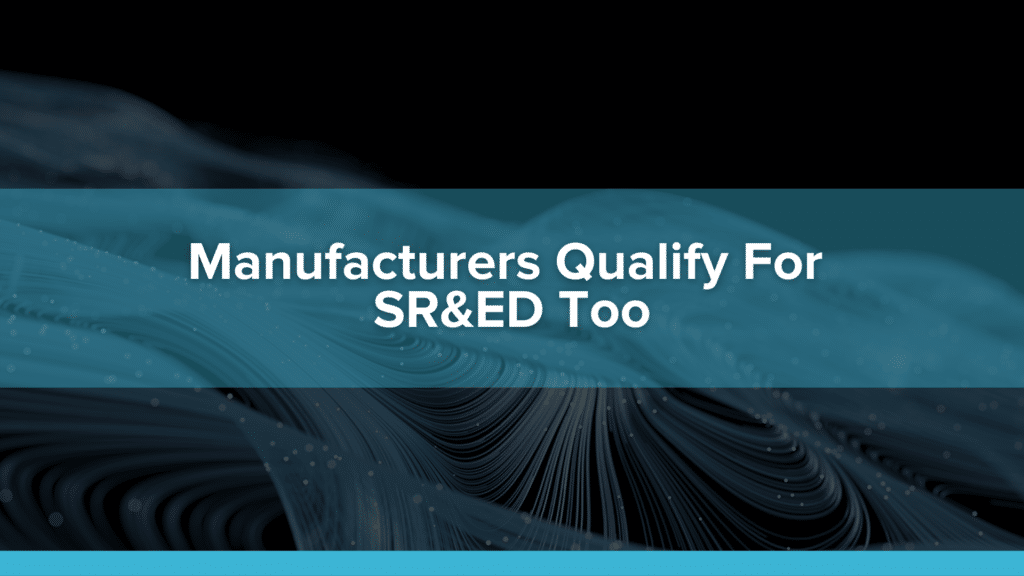There is a misperception that the Scientific Research & Experimental Development (SR&ED) tax credit is only applicable for companies in the Information Communications Technology (ICT) sector. This is false! While the root of a SR&ED claim is in the technology component, Canada’s R&D tax credit can still be applied in a number of industries.
In addition to ICT and software development, SR&ED eligible industries include agriculture, biotech, energy, and manufacturing.
In this blog, we’re going to take a closer look at the manufacturing sector and share some SR&ED eligible activities with you. Industry Canada defines this sector by those who are “primarily engaged in the physical or chemical transformation of materials or substances into new products.” This definition is very broad as it encompasses metals, wood, machinery, plastics, chemical, food, and textile manufacturers. And the list goes on.
Beyond initial testing and development, there are a lot of opportunities for companies to innovate. However, conducting R&D in the manufacturing sector can be quite capital intensive. Bombardier, Canada’s largest manufacturer of airplanes, is top R&D spender in Canada. In 2013, it spent over $2 billion in R&D, which was ~11.7% of annual revenue (Research Info Source, 2014).
Don’t have a $2 billion/year R&D budget? No problem. You can offset any and all eligible R&D expenses by claiming the SR&ED tax credit.
What is SR&ED eligible for manufacturers?
Manufacturers must meet these 3 criteria to qualify for SR&ED:
#1 – Technological Content
For SR&ED eligibility the work must be performed by qualified personnel with relevant experience in technology, processes, testing, engineering, programming, etc. They must incorporate a systematic investigation or approach.
#2 – Technological Uncertainty
There must be an element of uncertainty. For example, it may be uncertain whether the project’s technical requirements can be achieved. It may also be uncertain which design method that will yield the most accurate results or fastest installation, etc. To demonstrate uncertainty, manufacturers need to outline design alternatives, technology choices, equipment configurations and more.
#3 – Technological Advancement
The work must generate information that advances the company’s technological knowledge-base. When a new or improved product or process is created, it must contain a technological advancement in order to be SR&ED eligible.
Unfortunately, the following manufacturing-related activities don’t qualify for SR&ED:
[list list_style=”darkGrayDot”]
- Quality control or routine testing of materials, devices, products or processes;
- Commercial production of a new or improved material, device or product or the commercial use of a new or improved process;
- Prospecting, exploring or drilling for, or producing, minerals, petroleum or natural gas;
[/list]
Manufacturing Materials
In addition to salaries and sub-contractor fees, manufacturers are able to claim materials consumed or transformed in the process of SR&ED. According to the CRA’s interpretation, this refers to all the raw materials, substances, or other items, that compose the body of a thing at a given moment in the SR&ED process. Initial prototypes are typically claimed as materials consumed.
Examples of SR&ED eligible projects in the manufacturing sector:
[list list_style=”darkGrayDot”]
- assembly of component parts that were not originally intended to fit together.
- blending of materials.
- finishing of manufactured products by dyeing, heat-treating, plating and similar operations are also treated as manufacturing activities.
- product reformations, product adjustments and equipment changes.
- improving a process
[/list]
Brief case study on how much money a manufacturing company can recover
Company XYZ is a large manufacturing enterprise based in Edmonton, Alberta. It is classified as a CCPC (Canadian-controlled private corporation) with over $1.5M in annual taxable net income. Since they are over the small business limit they qualify for non-CCPC rates in the eyes of SR&ED.
Company XYZ is working on improving the durability and performance of their widgets while keeping their internal cost of goods sold the same.
They have hired 4 senior mechanical engineers and 1 sub-contractor 75% of their time on this project. The engineers’ salaries are $100K each and the sub-contractor fees total $125K.
Company XYZ can claim $300K ($100K x 4 x 75%) worth of salaries for their SR&ED claim. Since the program only allows 80% of sub-contractor fees to be claimed, only $100K will qualify ($125K x 80%). Assuming 100% of the sub-contractor’s work is SR&ED eligible and applying the proxy overhead method and non-CCPC rates, Company XYZ would qualify for ~$133K worth of investment tax credits (ITCs). For the step by step calculation, access our Ultimate Guide here.
Since they are a large non-CCPC, Company XYZ will receive their ITCs as a tax credit that can be applied indefinitely or carried back 3 years. If Company XYZ was a CCPC, their total ITCs would be $234K and all of it would be refundable!
We hope we’ve opened your eyes to the possibility of R&D and innovation in the manufacturing sector. If you have any questions, feel free to contact us directly.









